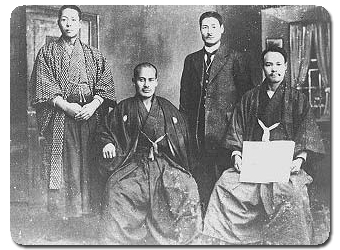 It is customary in martial arts practice to refer to a high-profile teacher whom many practitioners draw inspiration from. Today, the true Japanese Budo master has almost disappeared. Nevertheless, many of us express their preference by officially stating which Master we are following or inspiring our practice to. In my opinion, those statements need some clarification.
It is customary in martial arts practice to refer to a high-profile teacher whom many practitioners draw inspiration from. Today, the true Japanese Budo master has almost disappeared. Nevertheless, many of us express their preference by officially stating which Master we are following or inspiring our practice to. In my opinion, those statements need some clarification.
Besides certain “stalking” occurrences where someone’s tailing his own master, observing his behavior during the day, skulking in the shadows at night outside his home, “following” a master means attending his seminars and training “classes”.
Author: Pasquale Robustini
War not makes one great

The Ki awakens – How much Aikido in Star Wars?
Star Wars. Jedis and Samurais. The Force and the Ki. How many similarities! When Luke Skywalker in the second film of the original trylogy, The Empire Strikes Back, flies to the Dagobah system to meet master Yoda, he does not recognize him in the little funny being in front of him. Annoyed, he replies to the tiny one’s many questions trying to dismiss him by saying he’s looking for a “great warrior”. “Great warrior! Great Warrior? …War not makes one great“, is master Yoda’s wise reply. Aikido founder Morihei Ueshiba would have said the same. So bear with me as the Ki awakens…
Seishiro Endo for the third time in Rome – and I was not there

I’ve always claimed it: Aikido is really useful right when your morale is low. To avoid training when you are down in the dumps is a bit like avoiding food because you’re hungry. Until we don’t grasp this, we haven’t grasped the real essence of the practice.
Now, maybe I should refine the concept more, since this has just happened to me last weekend. I avoided practicing in a very important and luring seminar, even though I had paid in advance. Why? I didn’t feel like it, I had low spirits…
Vanity Budo

Japanese martial arts – properly speaking (I mean Budo, not Bujutsu) have been created as a means to self-improvement. The aikido founder clearly talked about a practice to shape honest and truthful people. Judo and karate, just to name the most famous, are no less. Probably, their involvement in combats and competitions, the prizes and the achievements affected the practitioners’ ego, which has been inflated instead of diminished. But aikido has no competitions, so the problem must be found elsewhere, since aikido is not certainly a discipline which is immune to attention-seeking behavior. Yet, one of the practice’s goals is exactly that: limit your ego.
Aikido and Sex
Come on! What’s the problem! Everybody knows Aikido is love, Aikido is life. Isn’t it?
So let’s start and in doing so, let me also point out that not all the concepts described below are my own, but they are also inspired to someone who knows far more about Aikido than me…
Someone says: “Why am I doing Aikido? Only for the girls…”. And he highlights the irony with: “I can touch all the women I want and I’m also being paid to do it!”. A very attractive practice, many will agree… And we can also easily overturn the matter in favor of the other sex (let alone for gay people!). I would also add: not only I’m paid for doing so, thay also thank me! During class, when the teacher practices with some of the couples, he tuns people upside down and etiquette requires them to even thank him! With a Japanese-style bow!
Aikido has much to do with sex. Irony comes easy when practice involves a couple rolling on a carpet while sweating and panting… Furthermore, we don’t talk about opponents but partners. Some teachers even urge partner exchange during class, although some more traditional schools rule that a couple should stay together forever (I mean, for the same training class). How boring…
 Jokes aside, what partners are really exchanging is certainly (besides some body fluids – sweat abounds) their roles: tori, the defending one, executes the technique (yang); uke, the attacker, undergoes the technique (yin). For the sake of precision, uke does not undergo a technique, he/she receives it, as the ethymology of the Japanese word would suggest. In that way, uke is training his/her own feminine side – indeed, receiving “is” a feminine role.
Jokes aside, what partners are really exchanging is certainly (besides some body fluids – sweat abounds) their roles: tori, the defending one, executes the technique (yang); uke, the attacker, undergoes the technique (yin). For the sake of precision, uke does not undergo a technique, he/she receives it, as the ethymology of the Japanese word would suggest. In that way, uke is training his/her own feminine side – indeed, receiving “is” a feminine role. So imagine a woman who, in dealing with a less experienced man, froze him on the spot, blocking any “ambition” he might have had from the beginning. Wouldn’t it be better if she helped him overcome his clumsiness so they would both enjoy of his own growth (pun intended)? This is the meaning of uke donating his/her own body to the partner, in a very active way, not by surrendering. Tori‘s strength, in turn, must be constructive, it must help uke to become strong, it’s not supposed to destroy him/her. Tori is not supposed to be there showing off how good he/she is while throwing an unfortunate uke back and forth; tori is at uke‘s service, he/she should perform the technique in the way uke will allow him/her, which is the only way to cause no damage. Damage in Aikido does not occur on the spot; it may surface later, after years of training in the wrong way. Uke‘s body, his/her posture, placement and dynamics during the technique, should guide tori in his/her execution; by doing so he/she would totally respect uke‘s body physiology. Isn’t tori at uke‘s service? To serve, saburau in Japanese, is where the word samurai comes from. Samurai is the one who serves, who takes care of the other one (see it?). The received technique should give uke pleasure – we aikidokas abhor sexual violence. Hey, someone is also talking about improving his sexual life through Akido practice! What are you waiting for?
So imagine a woman who, in dealing with a less experienced man, froze him on the spot, blocking any “ambition” he might have had from the beginning. Wouldn’t it be better if she helped him overcome his clumsiness so they would both enjoy of his own growth (pun intended)? This is the meaning of uke donating his/her own body to the partner, in a very active way, not by surrendering. Tori‘s strength, in turn, must be constructive, it must help uke to become strong, it’s not supposed to destroy him/her. Tori is not supposed to be there showing off how good he/she is while throwing an unfortunate uke back and forth; tori is at uke‘s service, he/she should perform the technique in the way uke will allow him/her, which is the only way to cause no damage. Damage in Aikido does not occur on the spot; it may surface later, after years of training in the wrong way. Uke‘s body, his/her posture, placement and dynamics during the technique, should guide tori in his/her execution; by doing so he/she would totally respect uke‘s body physiology. Isn’t tori at uke‘s service? To serve, saburau in Japanese, is where the word samurai comes from. Samurai is the one who serves, who takes care of the other one (see it?). The received technique should give uke pleasure – we aikidokas abhor sexual violence. Hey, someone is also talking about improving his sexual life through Akido practice! What are you waiting for?
Exams and failures
 In the summer of 2012, during the usual Philippe Gouttard seminar in Follonica (Tuscany), I failed my 3rd dan Aikikai exam with the great French master. Some would argue that my image as a teacher, although since a short while, could suffer a serious damage. Furthermore, the feelings after a failure are diverse. The will of practicing decreases a bit. You feel a somehow mentally tired knowing that all you’ve done was not enough, while you were convinced it was much. Like after a bicycle or horse accident, it is important to start over again soon! Thank God I was at a seminar, so, immediately after my failed test, I was back on the mat!
In the summer of 2012, during the usual Philippe Gouttard seminar in Follonica (Tuscany), I failed my 3rd dan Aikikai exam with the great French master. Some would argue that my image as a teacher, although since a short while, could suffer a serious damage. Furthermore, the feelings after a failure are diverse. The will of practicing decreases a bit. You feel a somehow mentally tired knowing that all you’ve done was not enough, while you were convinced it was much. Like after a bicycle or horse accident, it is important to start over again soon! Thank God I was at a seminar, so, immediately after my failed test, I was back on the mat!


